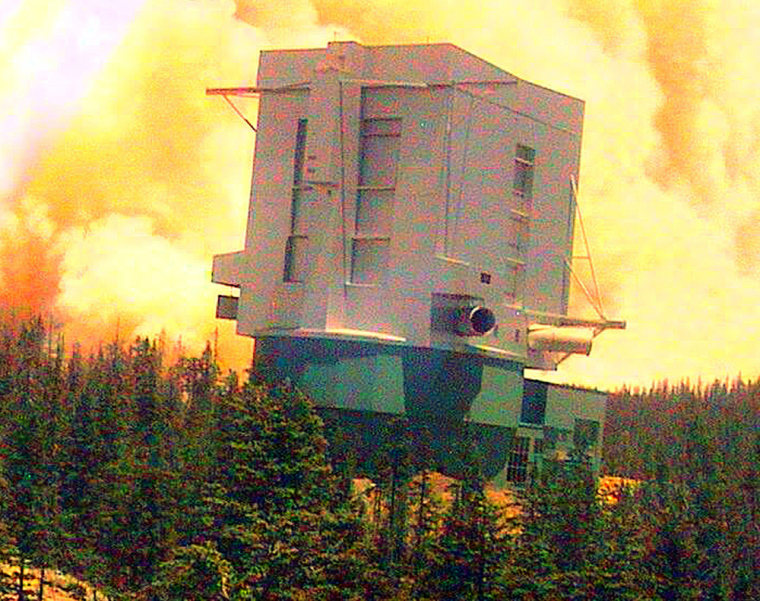The telescopes at the Mount Graham International Observatory peer into the heavens, seeking drama miles up in the sky. These days, though, the drama is much -- much -- closer to home.
A mountainside wildfire was within a quarter-mile of a $200 million mountaintop observatory Wednesday and firefighters are struggling to save the facility and the promises it can offer science.
It is the second time in eight years that a forest fire has threatened the observatory and scientists fear that even if the building doesn't burn, the smoke and heat could damage the delicate instruments inside.
The observatory is surrounded by a broad cleared area and has sprinklers. Fire lines around the blaze were holding, said fire crew spokesman Bill Duemling. Firefighters turned their attention to saving summer homes in two small communities.
Telescope set to be world's biggest
The observatory's third and largest telescope is partly finished. Once completed, the $120 million Large Binocular Telescope will become the world's most powerful optical telescope, capable of producing images nearly 10 times sharper than those from the Hubble Space Telescope.
One of its honeycombed glass mirrors -- 8.4 meters in diameter -- is in place and its twin is being polished. The second mirror could be installed as early as the fall of 2005.
Coupled with technology called adaptive optics to adjust and correct for the Earth's turbulent atmosphere, the telescope will have unprecedented capabilities -- power, range and viewing clarity -- within a limited range of wavelengths.
Astronomers who plan to use it for a scheduled 330 nights a year, at a cost of $18,000 a night to operate, will be able to see planets the size of Jupiter in solar systems 20 to 30 light-years away.
"This has never been done before," said Buddy Powell, director of the observatory, which is run by the University of Arizona. "We will have the opportunity to see if there are chemical elements to support life on other planets."
Peter Wehinger, a University of Arizona astronomer, said one colleague already has detected quasars -- extremely distant and powerful light sources -- dating back nearly 13 billion years.
There are two other telescopes that can scan deep space and detect tiny radiowaves atop Mount Graham, about 125 miles northeast of Tucson, and university officials hope to be able to build four more.
Environmentalists: We told you so
But controversy has swirled around plans for the Mount Graham International Observatory since it got its start 20 years ago atop the 10,700-foot mountain.
Environmentalists and members of an Indian tribe fought its development through some 40 lawsuits -- eight of which ended up before a federal appeals court -- but the University of Arizona prevailed.
Opponents contended the observatory would cause the demise of the endangered Mount Graham red squirrel, which are now imperiled by the wildfire. Members of the San Carlos Apache Tribe, meanwhile, asserted development would desecrate a sacred mountain.
Congress intervened in the project twice. In 1988, it authorized construction of the first telescope while exempting the project from review under the Endangered Species Act; in 1996, it ordered construction resumed after an appellate court had halted it over environmental issues.
Now that flames are closing in on the facility, old arguments about its location also have been reignited. A wildfire in 1996 came within a few hundred yards of the observatory complex but didn't damage it.
Dr. Robin Silver, a Phoenix physician and environmentalist who has fought the project for two decades, said fires are a natural part of the ecosystem on Mount Graham, but telescopes and astronomers are not.
"Over and over and over, the university astronomers were asked to please not build this facility in a volatile, fragile forest system," Silver said. "Those of us who warned them, who begged them and who pleaded with them ... are not going to feel sympathetic to whatever fate they might suffer."
